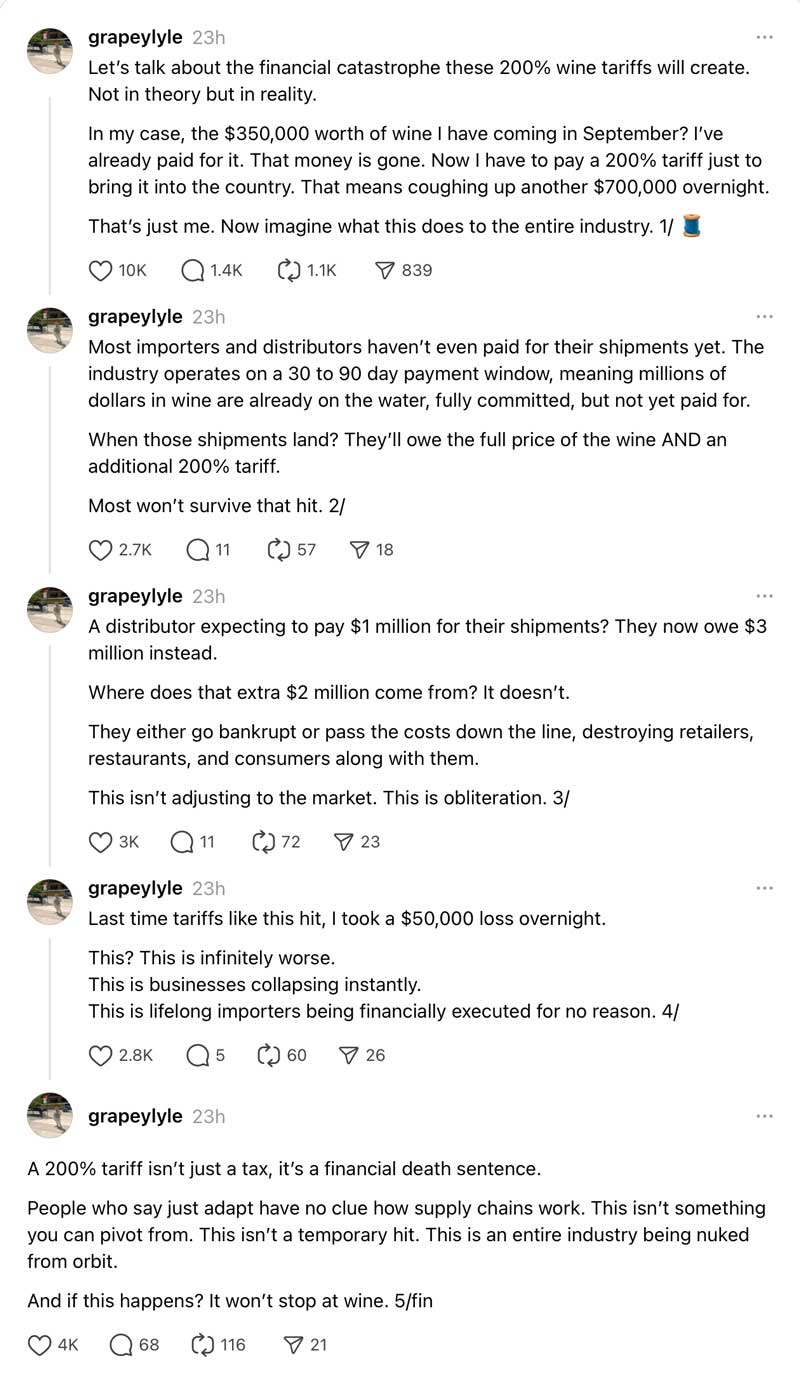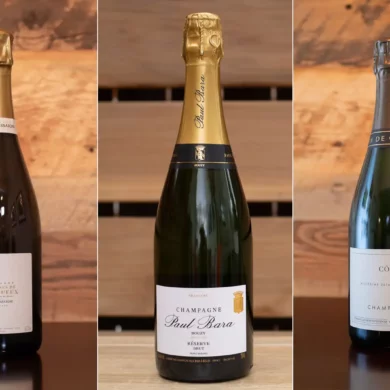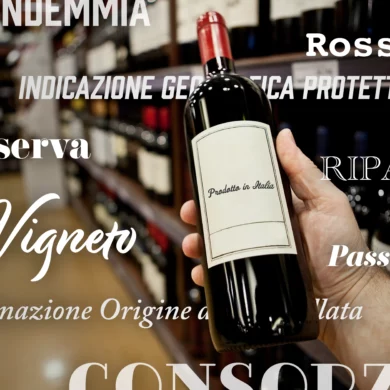You and I … we like wine. It’s a shared interest that enriches our lives and that — for many of us — employs us.
And because of that, I want to briefly wade into waters that I normally don’t touch: Politics. Specifically tariffs. And Trump.
Thought this was a safe space from all that? Yeah, I did too. But if his latest threat against the EU comes to fruition, it will not only make the subject matter of this website and my newsletter largely inaccessible, it’ll destroy American jobs, obliterate American-owned companies, and hollow out a lot of restaurants.
Sure, it will impact many of the small family producers who make the most compelling wines from Europe. My concern for them, however, is for another article. Because clearly, this is an Us vs. Them administration. A so-called “America First” administration that acts on impulse under the guise of decisiveness.
This impulse, however, will be decisively bad for American business and American consumers.
Here’s What Prompted This
By now, I figured many of you heard about yesterday morning’s salvo from President Trump:
“The European Union, one of the most hostile and abusive taxing and tariffing authorities in the World, which was formed for the sole purpose of taking advantage of the United States, has just put a nasty 50% Tariff on Whisky. If this Tariff is not removed immediately, the U.S. will shortly place a 200% Tariff on all WINES, CHAMPAGNES, & ALCOHOLIC PRODUCTS COMING OUT OF FRANCE AND OTHER E.U. REPRESENTED COUNTRIES. This will be great for the Wine and Champagne businesses in the U.S.”
President Donald Trump
on TruthSocial
Now, the EU should have/could have/might have predicted this when they proposed their retaliatory tariff targeted on Kentucky bourbons. Other proposed tariffs (like on Harley-Davidson motorcycles) were clearly targeted at red districts. This was goading. Surely they knew that the response would be something of this order.
So why did the EU go through with it? Well, because Trump’s response probably hurts our economy even more. Don’t take my word for it. Here is the simple math from importer Lyle Fass of Fass Selections, who posted this on Threads (follow him at @grapeylyle):

There have been hundreds of similar cases outlined since yesterday, but his spelled it out most clearly.
Now, I realize that there is a lot of performative chest-thumping with President Trump. And I understand that overall trade needs to be balanced and fair between two sides, and that alcohol and wine are part of a much larger thing at work here. Yeah, yeah, I get that. These tariff threats might actually prompt a favorable response on the other side of the pond, and that’s what he is hoping for by acting so disproportionate. It’s a game of chicken … I got it.
But clearly, even the idea of these tariffs and the uncertainty that it injects into American lives and American businesses is enough to cause trouble now. At Slow Wine Denver this week, I heard from several people in the industry who are making back-up career plans or, if they own a business, are holding off on any investments until there is stability on this front.
Some damage has already been done. It could be temporary. But if this crazy, disportionate number pulled out of thin air comes to pass, the damage to the alcohol economy could last a generation. Here’s how.
Loss of a Market
Anecdotally, the European producers I know have a great relationship with their American buyers. Together, they have built this market over decades, over generations. And they have their own issues with the EU, which are extensive.
Now a few weeks of conflict or temporary measures won’t undo all of that, but at a certain point, they will have to start diverting their stock to other markets. They likely won’t be able to make up for the American market shortfall — which is why this tariff is being pushed as leverage — but if it goes through, they’ll certainly adapt. They will have to. And the longer this goes on, the longer it’ll take to bring these products back to our market. Some might not come back at all.
As for American wineries and their exports, the retaliation has already begun in Canada, and will continue in Europe and other markets, limiting their ability to sell. So if this is meant to make things easier for domestic producers, it is not.
Distribution Pains for All
Domestic producers often rely on distributors to get their wines to market … often the same ones who also distribute imported products due to economies of scale. Given that many will be short-staffed (or fold entirely), this creates a new problem for domestic producers.
Even if the tariffs are negotiated away at a later date, this delicate system (a whole other issue for another day) would be massively strained for years to come. Again, this is not an overall win for domestic producers, let alone American businesses tied to wine.
“So We’ll Just Drink Domestic Wine”
You certainly could, and should, but there are a lot of flaws in the economic theory that tariffs will just prompt the market to buy American.
For one, wine is not interchangeable. There is only one place that can make Barolo, one place that make Chablis, one place that can make Rioja, and one place that can make Napa Cabernet. On the low-end of the sales spectrum, there is also only one place that makes Prosecco.
Secondly, there is nowhere near enough domestic wine to fill the void left by European imports. For perspective, when you combine the total wine volumes of France, Italy and Spain, it is nearly 5x more wine than the U.S. produces, and the U.S. is the No. 4 producer by volume. The No. 5 producing nation, Chile, produces less than half of the U.S.
That’s a massive shortfall. And with it, will likely come scarcity on quality wines, which will likely drive up prices on American wines further. For many drinkers, at a certain point, they’ll just stop buying wine, especially in restaurants where it is already exceedingly expensive.
Domestic Wine Needs European Wine (and Vice Versa)
Sometimes new consumers are introduced to wine via something European. Often it is the other way around. Wine as a whole needs this to earn new consumers. Limiting options limits the growth of the whole industry because it kneecaps it at the New Consumer level.
Big Ripples That Become a Tsunami
Lastly, as alcohol sales erode across the board from this new landscape, restaurants will bear the brunt. I don’t have an estimate on the lost wages or the potential unemployment or closed businesses in this sector, but it would be enormous given how many of them depend on alcohol to get in the black. This likely would be enough to drag down the entire economy when you see how it impacts commercial real estate.
Sense a theme here: it is not a win for domestic businesses.
So What Can You Do?
The primary group working against this effort from the wine industry is the U.S. Wine Trade Alliance or (USWTA). I defer to them on the best approach. It involves signing letters, expressing your concern to U.S. Representatives and U.S. Senators via phone calls, and supporting trade associations that are fighting this. Also: spread the word amongst your friends as you see fit.
I would also urge you to follow journalists and industry observers who are able to report on this much more closely and thoroughly than I can. Among them:
- Ben Aneff, the President of the USWTA
- Industry observer Tom Wark
- NYTimes wine critic Eric Asimov
- Journalist and Sommelier Jessica Dupuy, especially her Instagram account
Hopefully this is an empty threat and cooler heads will prevail. We’ve seen that before, but then again, this second term feels like uncharted waters in many, many ways. Just look at how the stock market is reacting.





Thank you for sharing this insight, Kevin. Whew!!! Fingers crossed in Oklahoma… V/R, Don Vino